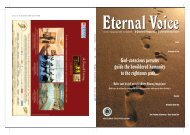Spiritualism - Eternal Voice
Spiritualism - Eternal Voice
Spiritualism - Eternal Voice
You also want an ePaper? Increase the reach of your titles
YUMPU automatically turns print PDFs into web optimized ePapers that Google loves.
Kirtan SamratBhai Samund SinghAn Ocean of Sikh Religious Music(1900 - 1972)By Prof. Ravinder Gargesh & Rajinder Singh Chadhahere are people who come to this world and make a noblepresence and depart noiselessly. Their noble presence isTfelt through their devotedness to what they believe in and whatthey do, particularly if these are rooted in their cultural ethos.The life of Bhai Samund Singh is like a beacon that shows thepath of happiness and fulfillment in today's complex world. Hislife displays a love for devotional music rooted in the desire torender Gurbani in its true classical Indian musical form thattouches the inner chords of consciousness and provides peace,succor and rationality to the living. Sixty five years of his lifewere devoted to seeking perfection in singing devotional musicin congregations, known as Kirtan. He had a unique melodiousvoice, an extensive and deep understanding of Gurbani, correctinterpretation of ragas, attractive style of singing and greathuman qualities. He is one of those rare gems, whose worth wasrecognized during his life time as well.Bhai Samund Singh rendered Gurbani Kirtan for 36 years fromAll India Radio, Lahore and later from Jalandhar; andcommanded wide listening. He got the unique distinction ofbecoming the first Sikh religious classical musician to perform aone-and-a-half hours long live program in the prestigiousweekly Akhil Bhartiya Program of Classical Music, the highestrecognition of his art, on a Saturday evening at the Delhi stationof AIR. He was also given the state award by the Punjabgovernment in 1971.Bhai Samund Singh was born on January 1, 1900 in anenvironment of devotional music and religion, in the family ofHazoora Singh and Karam Kaur in village Hamzan, DistrictMontgomery, now in Pakistan. His father worked with the ForestDepartment and also served as the Chief Sewadar at GurdwaraNankana Sahib, the birth place of Guru Nanak. He also performedKirtan along with his brother Bhai Gurdit Singh, who played theTabla. His grandmother Sada Kaur was a pious lady, who recitedSukhmani Sahib everyday. The religious atmosphere permeatedthe being of the child Samund Singh and he began to performKirtan on occasions like the Gurpurab and other religiousgatherings and conferences from the tender age of 7 years.While Samund Singh was still very young, his father had set avigorous training regimen for the aspirant, which continued forall times. Strict spiritual discipline (Nitnem) and regular Riaz(practice) of the ragas, was the hallmark of his life style. By theage of 12, Samund Singh had learnt a thousand Shabads fromGuru Granth Sahib by heart and recognizing his skills, he wasappointed Hazoori Ragi at Nankana Sahib, where he served inthat position till 1947. At the age of 15, his rendering ofKirat(i) karam k-ai veechh(u)arh-ei Kar(i) kirpaa m-ai-lah(u) Ram at the SikhEducational Conference at Ferozepur in 1915, won him a lot ofpraise. His father had provided the motivation and the youngSamund Singh got training in music from Mahant Sham Singh.Thereafter, he also acquired the complexities of the traditionalsystem of ragas from Bhai Hira Singh Pharukewala. He was alsoclose to a contemporary Ragi Bhai Sher Singh Gujranwale.Later, he also got inspiration from Bhai Pyara Singh Rababi andfrom the noted classical vocalist Bade Gulam Ali Khan.In 1947, after Partition, Bhai Samund Singh migrated to Indialeaving behind his home and belongings. But he brought withhim, with great care, his Tanpura for Riaz (practice of vocalmusic). Here he did not accept any position as a Ragi, neither ofHarmandir Sahib nor of the position of a Royal Ragi in theKingdom of Patiala. In fact, after experiencing the freedom atNankana Sahib, he did not want to be subservient to anyone. He,therefore, began to perform Kirtan wherever he was invited andof his own free will. Due to his artistic devotion to Gurmatmusic, he was often invited to the religious functions organizedby Sant Attar Singh Mastuanewale, Baba Nand SinghKaleranwale, Sant Sham Singh Attariwale, Sant Attar Singh HotiMardanwale, Sant Sangat Singh Kamaaliyewale and Sant IsharSingh Rarewale.Bhai Samund Singh was well-built, though of a less thanmedium height. He had prominent eyes and good facial featureswith a nice flowing beard. He was generally clad in whiteKurta-Pyjama, adorned a blue turban and wore an almondcolored waistcoat. He was of a jovial nature. He was young withthe young and old with the old. He was simple andopen-hearted. Due to his good and kind nature, Bhai Teja Singhand Bhai Harnam Singh were part of his team for performingKirtan for many years. He was also a successful householder. Hegot his three daughters and his only son high education and allof them are well-settled in life. He was also fond of maintaininga floral garden as well as a good kitchen garden.Many institutions have created people for the occupation ofKirtan, but none has replaced Bhai Samund Singh. Kirtan in theSikh tradition had begun from the time of Guru Nanak and thiswas carried forward by Guru Arjan, by providing Gurbani withthe form and format of Indian classical music, so much so thatthe Guru declared Kirtan as the main medium of salvation:kljug mih kIrqnu prDwnw ] (1075)Kaljug meh kirtan pardhaanaa.(In this Dark Age of Kali Yuga, the Kirtan of the Lord's Praises ismost sublime and exalted.)Nov, 2010 - Jan, 201145





